The central lobeThe top part represents the independence of 1810. Vine leaves are seen at the center illustrating Miguel Hidalgo's response to the Spanish prohibition against growing grapes to further the Spanish sale of wine. Hildago himself is seen above with the broken chains of slavery. Morelos, priest and student of Hidalgo, is depicted with arm outstretched and with an oversized hand. |
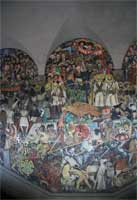
|
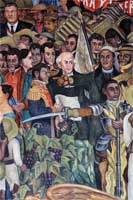
|
The figure below Morelos extending the sword is Martín Cortée, known as "El mestizo." The son of Hernán Cortés and Doña Marina, he was educated in Spain and returned to Mexico in 1563 to take part in a conspiracy, which eventuated in his permanent expulsion from Mexico. From a much earlier period, this figure is an example of the vertical slippage in the murals. |
| |
|
Recognizable portraitsIn the upper part of the lobe a worker and a peasant hold a banner with the Zapatista slogan, Tierra y Libertad (Land and Liberty). Emiliano Zapata, the agrarian revolutionary leader, is on left side of this banner in a large sombrero. Next to him is Felipe Carrillo Puerto, a progressive governor of Yucatán, and next to him is another agrarian leader José Guadalupe Rodríquez. Just under the worker's outstretched arm and pointing finger is Plutarco Elías Calles, who comes under Rivera's satiric brush in the stairway murals on the left hand side. The green flag on the top left is the banner of the Three Guarantees; on September 27, 1821, the Army of the Three Guarantees led by Iturbide entered Mexico City, signalling the independence of Mexico. Iturbide (who briefly became emperor)is depicted in the red and white regal costume in front of the flag while next to him in red vest holding the banner is Vicente Guerrero, who added his troops to the Trigarante army entering Mexico with those of Iturbide, although he later helped to depose Iturbide from the throne. This section of the mural is a veritable portrait gallery with many other portraits of those who fought for independence. |
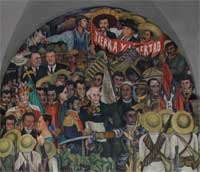
|
| |
|
Left: Hernán Cortés with vizer up on horseback leading the attack; below him the Ttlaxcalteca warrior who has sided with the Spanish, holding a Spanish sword Above the scene with Cortés and cavalry, Rivera depicts the natives. Cuauhtémoc, last of the Aztec emperors, dressed in an eagle costume, leads the defense of Tenochtitlán. He and his similarly dressed warriors are no more successful than the Aztec priest (detail center) standing next to him who offers up a Spanish victim's heart (The bloody chest from which the heart was ripped can be seen in front of him.) |
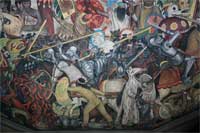
|
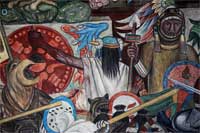
|
|
| |
|
| "The Mexican eagle holding in its beak the mexica symbol of the holy war (atl-tlachinolli), combining water and fire, rests on a nopal tree above a platform decorated with a solar disc" (Lozano ans Rivera 221). |
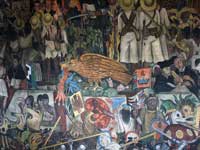
|
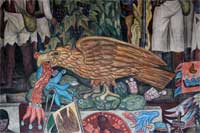
|
| |
|
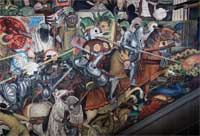
|
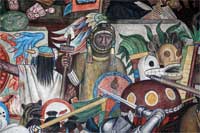
|
Battle details and Cuitláhuac (center image), brother of Moctezuma II |


 Go to Rivera Murals Index.
Go to Rivera Murals Index. Go to the Mexico Index.
Go to the Mexico Index. Click here to return to index of art historical sites.
Click here to return to index of art historical sites.
 Click here to return to index of artists and architects.
Click here to return to index of artists and architects.
 Click here to return to chronological index.
Click here to return to chronological index.
 Click here to see the home page of Bluffton University.
Click here to see the home page of Bluffton University.

